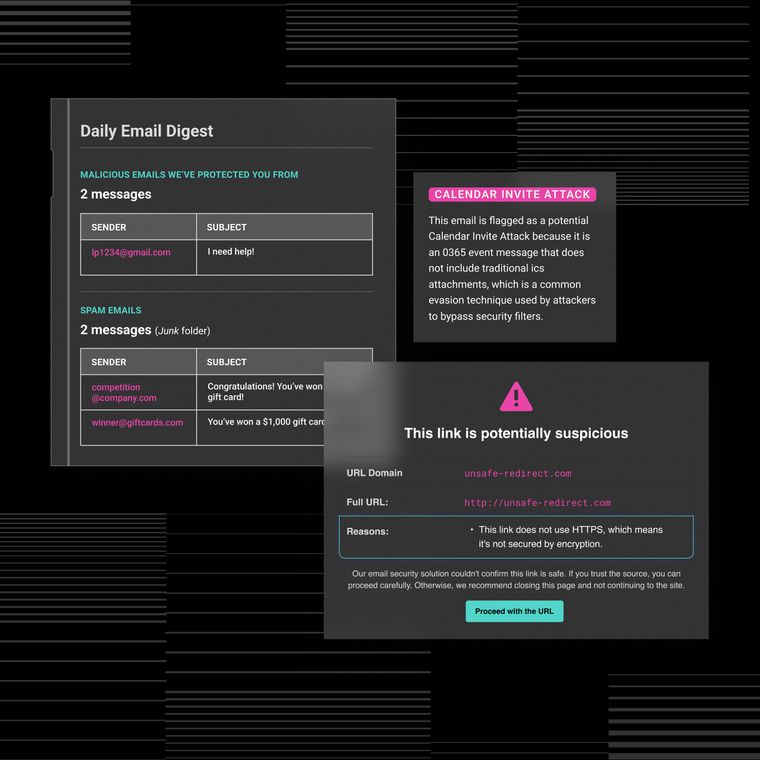How Behavior-Based Threat Detection Catches What Rules Miss
See how behavior-based threat detection identifies risks traditional rules can’t catch.
October 15, 2025
In 2024, cybercriminals stole $60 million from a leading carbon products supplier after tricking an employee into multiple wire transfers. This exemplifies how a single spoofed vendor email or compromised OAuth token can devastate organizations that rely on rule-based defenses.
Modern attack surfaces expand daily through cloud migrations, SaaS integrations, and collaboration tools. Every email address, API token, and OAuth connection creates new entry points. Rule-based tools cannot spot context-aware phishing links mimicking routine business exchanges.
Behavioral AI changes this dynamic by learning normal communication patterns and flagging subtle deviations across email, Slack, and all organizational channels. The technology recognizes warning signs before they become incidents.
Here are seven ways behavior-based threat detection captures what rules miss.
1. Baseline Normal Communication to Surface Anomalies
Dynamic baselining reveals the instant a user, vendor, or application deviates from established patterns. Behavioral AI understands normal behavior across users, applications, and systems to detect anomalies, creating living models of your organization's actual communication flows.
During the initial learning period, the platform maps tone, timing, frequency, and workflow patterns across email, Slack, and Teams. It charts who communicates with whom, when approvals typically occur, and how data moves between systems. These baselines refresh continuously, making subtle deviations immediately visible; an after-hours wire transfer request or unusual burst of direct messages triggers precise alerts.
This approach delivers context-rich detection grounded in organizational reality rather than rigid signatures. Anomalies represent genuine risks, not noise, because the system understands what normal looks like for your specific environment.
2. Stop First-Seen Attacks Before a Signature Exists
Adaptive detection catches first-seen domains and zero-day techniques the instant they appear, before any signature exists to block them. Traditional filters rely on known patterns and miss zero-day exploits and language-based attacks that evade signature-based filters, leaving organizations exposed when attackers strike for the first time.
Consider a newly registered look-alike domain, like invoicing-acme.com instead of acme.com, and send a well-timed payment request. The domain, URL, and payload do not match any existing rules, so legacy tools remain silent while finance teams process a fake invoice.
Advanced platforms assign anomaly scores immediately upon detecting unfamiliar senders, unusual communication paths, or out-of-character linguistic tones. This approach delivers real-time alerts without waiting hours or days for signature updates, blocking novel phishing lures, polymorphic malware, and AI-generated attacks on first contact.
This adaptive detection closes the critical gap left by rule-based systems, protecting against threats that have never been seen before.
3. Detect Relationship Impersonation and Vendor Fraud
Intelligent analysis stops executive spoofing and vendor fraud by analyzing every communication against established profiles of trusted contacts and partners. For instance, impersonation detection solutions help identify CEO fraud, spoofing, and domain lookalikes with language understanding and modeling that builds rich historical profiles capturing typical communication patterns, payment workflows, and interaction timing.
The system flags anomalies when a supposed partner emails from a first-seen domain or introduces urgent language into routine invoice requests. While legacy signature-based defenses miss these sophisticated tactics, behavioral AI engines analyze tone, timing, and payment flows to detect requests that deviate from established vendor cadence or arrive from unfamiliar locations at suspicious hours.
By correlating these patterns across email, Slack, and Teams, the platform delivers high-confidence alerts before funds transfer, preventing business email compromise and its associated losses.
4. Read the Context and Not Just the Content
Advanced detection analyzes the full context of communications—tone, urgency, language patterns, and sender relationships—to catch threats that hide behind seemingly normal content. NLP-driven analysis evaluates every word you send or receive to expose threats that static rules overlook, using advanced natural language processing to detect threats hiding in plain sight within text-based communication.
Consider this scenario: a long-time supplier suddenly demands an "urgent" wire transfer before day's end. The subject line feels panicked, the sentences are terse, and the sender's phrasing strays from years of routine dialogue. Modern models compare that message against linguistic baselines built from continuous monitoring, score each deviation, and elevate only high-risk anomalies for review.
NLP understands context, who normally requests payments, how they phrase them, and when they send them. It stitches isolated red flags into a single, high-confidence alert. This layered approach cuts false positives while surfacing truly novel attacks, transforming security analysis from content scanning to relationship intelligence.
5. Identify Compromised Accounts in Real Time
Advanced account takeover protection stops credential theft the moment attackers begin operating under stolen identities. The system detects compromised accounts via login anomalies, shifts in communication patterns, and unusual activity patterns, comparing every action against each user's historical baseline across email, chat, and cloud services.
Three critical signals reveal account compromise, including:
New login geography, especially impossible travel between time zones, just minutes apart
Unexpected device changes or unusual session length patterns
Atypical language, tone, or subject matter in outbound messages
Cross-channel correlation transforms these individual signals into definitive alerts. A suspicious wire transfer request following a foreign login carries far more weight than either event in isolation. Rule-based tools analyze each log source independently, creating blind spots that attackers consistently exploit.
Real-time anomaly scoring enables immediate account quarantine within seconds, protecting business operations while maintaining a low false-positive rate.
6. Unmask Slow-Burn Social Engineering Campaigns
Sophisticated detection catches social engineering campaigns unfolding over weeks or months by tracking the evolution of conversations rather than analyzing isolated messages. Traditional rule-based systems miss these attacks because each email appears legitimate, which are threats that only emerge when viewing complete sequences.
Behavioral AI monitors incremental shifts over extended timeframes: subtle changes in writing style, new after-hours communication patterns, and gradually escalating urgency. Deviations measured against personal baselines for each sender trigger early alerts, even for minor anomalies.
This timeline-aware approach transforms weeks-long manipulation into early-detection opportunities, cutting attack chains short when traditional tools see only routine correspondence.
7. Cut False Positives and Analyst Fatigue
Smart detection eliminates alert noise by learning standard patterns for your environment and surfacing only meaningful deviations. Security teams waste time investigating false alarms generated by traditional rule sets, which could be better used to focus on real threats.
Behavioral intelligence solutions and platforms continuously refine dynamic baselines for every user, vendor and application. They prioritize alerts based on real deviations, not static policy violations. This automatic adaptation eliminates the endless rule-tuning that burdens traditional tools, freeing analysts to investigate high-fidelity threats rather than triage benign events.
Organizations report significantly fewer tickets after deploying intelligent detection, translating into faster investigations and lower operating costs. The result is a more efficient SOC that handles rising attack volumes without expanding headcount.
Get Smarter Protection with Abnormal AI
Intelligent threat detection fills critical gaps left by rule-based systems, providing insights into threats that legacy tools miss. Abnormal AI distinguishes itself through cloud-native API deployment, graph intelligence, and cross-channel visibility, ensuring accurate threat recognition.
Unlike static solutions, adaptive behavioral AI adjusts to evolving threats, offering proactive protection with real-time alerts and actionable threat analytics. The platform transforms email from vulnerability into a defensive advantage by detecting multi-stage campaigns, vendor compromises, and payload-free attacks that bypass traditional defenses.
Ready to enhance your organization's security posture with intelligent threat detection? Get a demo to see how Abnormal can protect your communication ecosystem from sophisticated attacks.
Related Posts
Get the Latest Email Security Insights
Subscribe to our newsletter to receive updates on the latest attacks and new trends in the email threat landscape.


